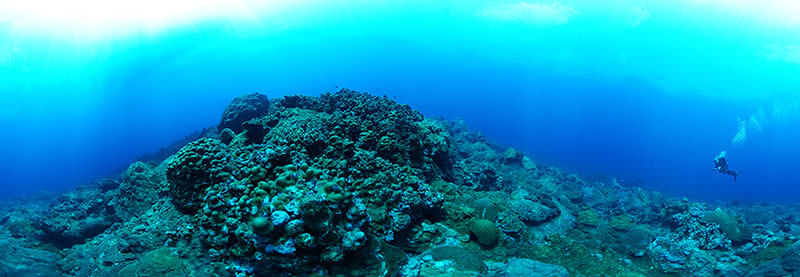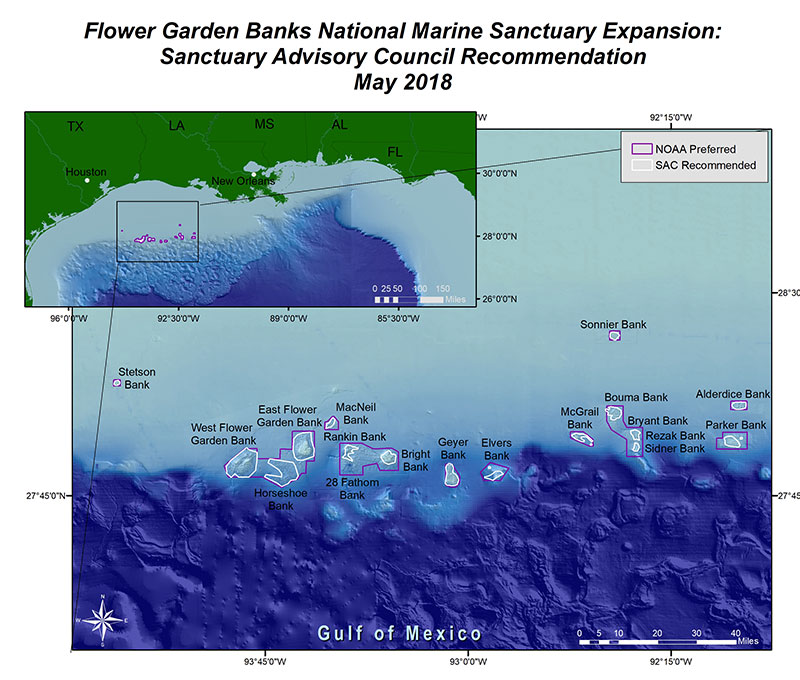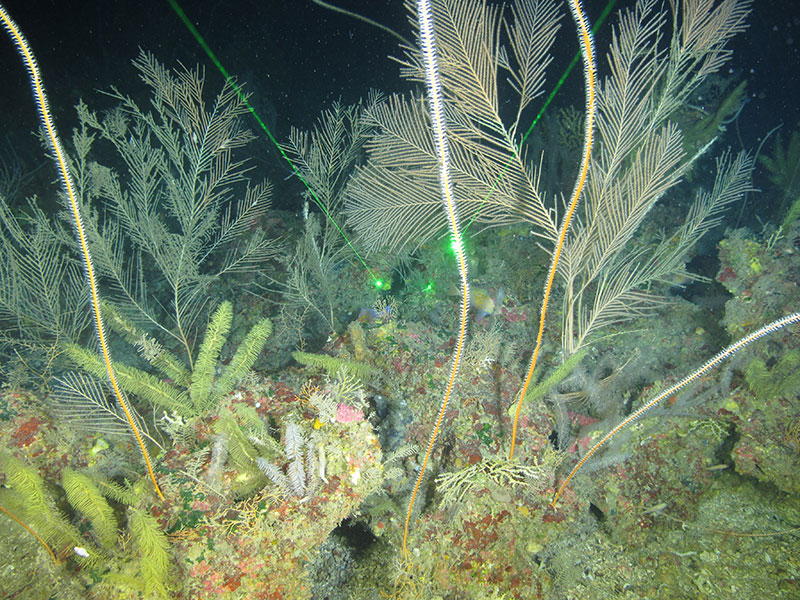
By G.P. Schmahl, Superintendent
Emma Hickerson, Research Coordinator
NOAA Flower Garden Banks National Marine Sanctuary

Figure 1. The coral reefs of the Flower Garden Banks National Marine Sanctuary have over 50 percent coral cover, dominated by massive star and brain corals. This panoramic image was taken on the flanks of the East Flower Garden Bank, where coral cover is upwards of 80 percent. The corals here grow in a more flattened form to capture as much light as possible to maximize photosynthesis by their symbiotic algae, which live in the tissues of the coral animals. Image courtesy of Flower Garden Banks National Marine Sanctuary/Hickerson. Download larger version (jpg, 4.0 MB).
The Flower Garden Banks National Marine Sanctuary is home to spectacular coral reefs—with massive boulder and brain corals dominating the landscape, as far as a diver can see (Figure 1). The sanctuary protects three separate locations in the Northwestern Gulf of Mexico—Stetson Bank (70 miles southeast of Galveston, Texas) and the West and East Flower Garden Banks (100-110 miles from Galveston, located 12 miles apart). These reefs provide habitat for countless marine animals including crustaceans, mollusks, sponges, fishes, sea turtles, sharks, and rays. The sanctuary was designated in 1992 to protect a 56-square-mile area, primarily in response to the expansion of oil and gas exploration and extraction to the outer continental shelf, and to protect the fragile coral reefs growing on top of these seafloor features.
The Flower Garden Banks National Marine Sanctuary is currently proposing to expand the sanctuary to include additional reefs and banks to the east of the current sanctuary boundaries (Figure 2). This proposal was based on over 30 years of research. In the 1970s, explorations by researchers from Texas A&M University (funded by the Bureau of Land Management, a precursor to today’s Bureau of Ocean Energy Management) found the shallowest portions of the reefs and banks in the Northwestern Gulf of Mexico to be covered with coral and coralline algae reefs. In 1974, the Bureau of Land Management designated these areas as No-Activity Zones to protect them from direct impact from oil and gas exploration and production. These zones were based on the best available data at the time and followed depth contours surrounding the uppermost portions of the banks.

Figure 2. The Flower Garden Banks National Marine Sanctuary is proposing to expand the boundaries of the sanctuary to portions of the areas shown in red. Image courtesy of Flower Garden Banks National Marine Sanctuary/Nuttall. Download larger version (jpg, 3.2 MB).
Since 1998, the Flower Garden Banks National Marine Sanctuary and partners have collected high-resolution multibeam bathymetry and used this as a guide to conduct extensive exploration of the reefs and banks in the Northwestern Gulf of Mexico. These surveys have documented the existence of significant mesophotic coral ecosystems in the depths both within and below the No-Activity Zones. These mesophotic coral ecosystems harbor dense communities of black corals, octocorals, sponges, and associated invertebrates, which provide habitat for recreationally and commercially important fishes (Figure 3).
Much of the research conducted to date has been exploratory in nature, characterizing species presence/absence and habitats. The purpose of this project is to increase our understanding of the genetic connectivity between organisms living on each of the banks and reefs. Are species found on one bank/reef members of the same population found on another bank/reef or are they separate populations? From a management perspective, understanding these connections helps us identify the level of importance of a community and what the community provides to the greater ecosystem – whether it’s a source for genetic stock or benefits directly from upstream sources, or both.
These areas of study are of interest not only to NOAA's Office of National Marine Sanctuaries, but to regulatory agencies of other users – primarily fishing and the oil and gas industry. The Bureau of Ocean Energy Management is the regulatory agency for the oil and gas industry and establishes the No-Activity Zones, as well as other protective measures. NOAA’s National Marine Fisheries Service, through the Gulf of Mexico Fishery Management Council, manages fisheries and fisheries habitat. Knowing where key habitats are located, and how important they are at the ecosystem level, helps guide agency-level decisions of these resources to protect and conserve the marine environment in the Northwestern Gulf of Mexico for generations to come.

Figure 3. A dense coral garden harboring octocorals, black corals, coralline algae, sponges, and cup corals, located at Elvers Bank at 117 meters (384 feet) depth. Image courtesy of Flower Garden Banks National Marine Sanctuary/University of North Carolina at Wilmington, Undersea Vehicles Program. Download larger version (jpg, 6.9 MB).